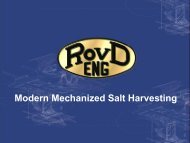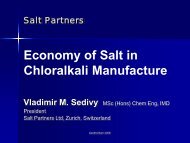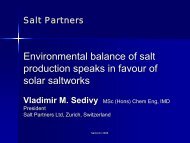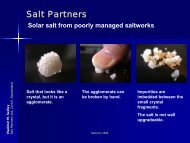Economy of Salt in Chloralkali Manufacture
Economy of Salt in Chloralkali Manufacture.pdf - ResearchGate
Economy of Salt in Chloralkali Manufacture.pdf - ResearchGate
- No tags were found...
Create successful ePaper yourself
Turn your PDF publications into a flip-book with our unique Google optimized e-Paper software.
National <strong>Salt</strong> Conference 2008, Gandhidham<br />
<strong>Economy</strong> <strong>of</strong> <strong>Salt</strong> <strong>in</strong> <strong>Chloralkali</strong> <strong>Manufacture</strong><br />
Vladimir M. Sedivy MSc (Hons) Chem Eng, IMD<br />
President, <strong>Salt</strong> Partners Ltd., Zurich, Switzerland<br />
Email: vladimir.m.sedivy@salt-partners.com<br />
Impurities <strong>in</strong> salt are costly. Impurities dissolve <strong>in</strong> electrolytic br<strong>in</strong>e and need to be removed, employ<strong>in</strong>g<br />
expensive processes and chemicals. The cost <strong>of</strong> br<strong>in</strong>e purification is high. Therefore, pure salt is more valuable.<br />
<strong>Chloralkali</strong> producers are will<strong>in</strong>g to pay higher price for purer salt.<br />
This paper deals with the technical aspects <strong>of</strong> the use <strong>of</strong> salt <strong>in</strong> the chloralkali <strong>in</strong>dustry, expla<strong>in</strong>s under what<br />
conditions the consumption <strong>of</strong> br<strong>in</strong>e purification chemicals can safely be reduced and <strong>of</strong>fers the economic rules<br />
that can be used for estimat<strong>in</strong>g the additional value <strong>of</strong> pure salt. The ma<strong>in</strong> pr<strong>in</strong>ciples <strong>of</strong> high quality solar salt<br />
production and the related economy are expla<strong>in</strong>ed.<br />
Advanced technologies, such as SOLARSAL saltworks design and operation, BIOSAL biological solar saltworks<br />
management and HYDROSAL salt purification process with hydroextraction <strong>of</strong> impurities facilitate pr<strong>of</strong>itable<br />
production <strong>of</strong> high quality solar salt for chloralkali <strong>in</strong>dustry, for human consumption and for exports.<br />
<strong>Salt</strong> is a most important raw material for chemical <strong>in</strong>dustry<br />
The annual world production <strong>of</strong> salt exceeds 200 million tons. Approximately one third <strong>of</strong> the total is produced by<br />
solar evaporation <strong>of</strong> sea water or <strong>in</strong>land br<strong>in</strong>es. Another one third is obta<strong>in</strong>ed by m<strong>in</strong><strong>in</strong>g <strong>of</strong> rock salt deposits,<br />
both underground and on the surface. The balance is obta<strong>in</strong>ed as br<strong>in</strong>es, ma<strong>in</strong>ly by solution m<strong>in</strong><strong>in</strong>g. Br<strong>in</strong>es can<br />
be used directly, for example <strong>in</strong> diaphragm electrolysis, or thermally evaporated to produce vacuum salt.<br />
<strong>Salt</strong> type<br />
Solar salt<br />
Rock salt<br />
Br<strong>in</strong>es and vacuum salt<br />
World production<br />
90,000,000 t/y<br />
60,000,000 t/y<br />
80,000,000 t/y<br />
The chemical <strong>in</strong>dustry is the largest salt consumer <strong>of</strong> salt us<strong>in</strong>g about 60% <strong>of</strong> the total production. This <strong>in</strong>dustry<br />
converts the salt ma<strong>in</strong>ly <strong>in</strong>to chlor<strong>in</strong>e, caustic soda and soda ash. Without these basic <strong>in</strong>organic chemicals, the<br />
chemical <strong>in</strong>dustry, glass production, etc. would be unth<strong>in</strong>kable. The second largest user <strong>of</strong> salt is mank<strong>in</strong>d itself.<br />
Humans need about 20% <strong>of</strong> the total salt produced to support their physiological functions and eat<strong>in</strong>g habits.<br />
About 20% <strong>of</strong> salt is needed for road de-ic<strong>in</strong>g, water treatment, production <strong>of</strong> cool<strong>in</strong>g br<strong>in</strong>es and many other,<br />
smaller applications.<br />
<strong>Salt</strong> user<br />
Caustic / chlor<strong>in</strong>e<br />
Soda ash and other<br />
Human consumption<br />
Road de-ic<strong>in</strong>g<br />
Other<br />
<strong>Salt</strong> consumption<br />
90,000,000 t/y<br />
50,000,000 t/y<br />
50,000,000 t/y<br />
20,000,000 t/y<br />
20,000,000 t/y<br />
Impurities <strong>in</strong> natural salts<br />
Sodium chloride is the ma<strong>in</strong> component <strong>of</strong> natural common salt. Natural salt is never pure. It conta<strong>in</strong>s impurities,<br />
ma<strong>in</strong>ly orig<strong>in</strong>at<strong>in</strong>g from sea water. Solar sea salts are rather similar. Rock salts vary greatly <strong>in</strong> purity, colour,<br />
<strong>in</strong>solubles, etc. Lake salts conta<strong>in</strong> components leached from the ground <strong>in</strong> variable quantities. <strong>Salt</strong> lake<br />
<strong>Economy</strong> <strong>of</strong> <strong>Salt</strong> <strong>in</strong> <strong>Chloralkali</strong> <strong>Manufacture</strong>.docx<br />
24-Apr-08
National <strong>Salt</strong> Conference 2008, Gandhidham<br />
Page 2 <strong>of</strong> 9<br />
chemistry is a science <strong>of</strong> its own. Calcium sulphate is always present <strong>in</strong> sodium chloride. In rock salt, it is<br />
present as anhydrite, hemihydrite or polyhalite. In sea salt and lake salt it is found as gypsum. Natural br<strong>in</strong>es<br />
are usually saturated with calcium sulphate. Magnesium is always present <strong>in</strong> the sea salt as magnesium<br />
chloride and magnesium sulphate. In lake salts, also sodium sulphate, calcium chloride, potassium chloride,<br />
sodium bromide and iodide may be found <strong>in</strong> exceptionally high concentrations. Insolubles are present <strong>in</strong> natural<br />
salts <strong>of</strong> all orig<strong>in</strong>s.<br />
Rock salt Sea salt Lake salts Br<strong>in</strong>es<br />
CaSO 4 0.5 - 2% 0.5 - 1% 0.5 - 2% Saturated<br />
MgSO 4 Traces 0.2 - 0.6% Traces Traces<br />
MgCl 2 0.3 - 1% Traces<br />
CaCl 2<br />
Traces<br />
Na 2 SO 4<br />
Traces<br />
KCl<br />
Traces<br />
NaBr<br />
Traces<br />
Insolubles 1 - 10% 0.1 - 1% 1 - 10%<br />
Elements such as alum<strong>in</strong>ium, barium, fluor<strong>in</strong>e, iron, nitrogen, phosphorous, silica, strontium, etc., heavy metals<br />
such as cadmium, chromium, copper, manganese, molybdenum, nickel, vanadium, etc., and poisonous<br />
elements such as arsenic, mercury, lead, etc., are <strong>of</strong> <strong>in</strong>terest <strong>in</strong> the chemical <strong>in</strong>dustry. Their content <strong>in</strong> the salt<br />
should be known when salt is used as feedstock <strong>in</strong> the chloralkali <strong>in</strong>dustry, particularly <strong>in</strong> the electrolysis us<strong>in</strong>g<br />
ion exchange membranes.<br />
How does the chemical <strong>in</strong>dustry deal with impurities <strong>in</strong> salt?<br />
In the chemical <strong>in</strong>dustry, salt is dissolved together with the impurities <strong>in</strong> water or br<strong>in</strong>e. Prior to feed<strong>in</strong>g to the<br />
process, the br<strong>in</strong>e is purified. Failure to purify the br<strong>in</strong>e may have serious, even lethal consequences.<br />
In electrolytic cells, excessive magnesium causes hydrogen evolution on the anode. Hydrogen and chlor<strong>in</strong>e<br />
form an explosive mixture. Explosion may damage the equipment and release chlor<strong>in</strong>e to the environment.<br />
Chlor<strong>in</strong>e gas is highly poisonous. The elim<strong>in</strong>ation <strong>of</strong> magnesium is <strong>of</strong> prime concern.<br />
Erratic impurity content <strong>in</strong> salt may cause hardness breakthrough to the electrolytic cells. Impurities will damage<br />
the ion exchange membranes. Membranes cost a fortune, several hundred US dollars per square meter. The<br />
purer the salt, the more remote is the danger <strong>of</strong> membrane damage.<br />
In soda ash production, excessive sulphate reduces the value <strong>of</strong> the product. Calcium accumulat<strong>in</strong>g <strong>in</strong> the<br />
process causes encrustations. Periodical scale removal is costly and leads to loss <strong>of</strong> production.<br />
Therefore, <strong>in</strong> the chemical <strong>in</strong>dustry, impurities from salt dissolved <strong>in</strong> br<strong>in</strong>e are precipitated with chemicals and<br />
removed by various processes. The cost associated with br<strong>in</strong>e purification is the cost <strong>of</strong> chemical reagents and<br />
the <strong>in</strong>vestment and operat<strong>in</strong>g cost <strong>of</strong> the br<strong>in</strong>e treatment plants. The cost <strong>of</strong> contam<strong>in</strong>ated sludge disposal,<br />
purge decontam<strong>in</strong>ation and the loss <strong>of</strong> salt <strong>in</strong> purge also represent substantial costs.<br />
Calcium, magnesium and sulphate precipitation<br />
The precipitation <strong>of</strong> calcium, magnesium and sulphate from br<strong>in</strong>e is described by the follow<strong>in</strong>g chemical<br />
reactions:<br />
Calcium precipitation Ca ++ + Na 2 CO 3 = CaCO 3 + 2 Na +<br />
40 108 100<br />
This chemical reaction shows that each 40 kg <strong>of</strong> calcium impurity enter<strong>in</strong>g the chloralkali process with salt<br />
requires 108 kg <strong>of</strong> soda ash for precipitation and formation <strong>of</strong> 100 kg <strong>of</strong> calcium carbonate.<br />
<strong>Economy</strong> <strong>of</strong> <strong>Salt</strong> <strong>in</strong> <strong>Chloralkali</strong> <strong>Manufacture</strong>.docx<br />
24-Apr-08
National <strong>Salt</strong> Conference 2008, Gandhidham<br />
Page 3 <strong>of</strong> 9<br />
Magnesium precipitation Mg ++ + 2 NaOH = Mg(OH) 2 + 2 Na +<br />
24 82 58<br />
This chemical reaction shows that each 24 kg <strong>of</strong> magnesium impurity enter<strong>in</strong>g the chloralkali process with salt<br />
requires 82 kg <strong>of</strong> sodium hydroxide for precipitation and formation <strong>of</strong> 58 kg <strong>of</strong> magnesium hydroxide.<br />
Sulphate precipitation with BaCO 3 SO 4 -- + BaCO 3 = BaSO 4 + CO 3<br />
--<br />
96 197 233<br />
Sulphate precipitation with BaCl 2 SO 4 -- + BaCl 2 = BaSO 4 + 2 Cl -<br />
96 208 233<br />
Sulphate precipitation with CaCl 2 SO 4 -- + CaCl 2 = CaSO 4 + 2 Cl -<br />
96 111 136<br />
These chemical reactions show that each 96 kg <strong>of</strong> sulphate impurity enter<strong>in</strong>g the chloralkali process with salt<br />
requires either 197 kg <strong>of</strong> barium carbonate or 208 kg <strong>of</strong> barium chloride or 111 kg <strong>of</strong> calcium chloride for<br />
precipitation and formation <strong>of</strong> either 233 kg <strong>of</strong> barium sulphate or 136 kg <strong>of</strong> calcium sulphate.<br />
Overdos<strong>in</strong>g <strong>of</strong> br<strong>in</strong>e purification chemicals<br />
The above chemical reactions require that more than the stoichiometric quantity <strong>of</strong> the reagent is added to the<br />
br<strong>in</strong>e to fully precipitate the impurity. This additional quantity is called overdosage. The overdosage<br />
requirements are as follows:<br />
Calcium precipitation<br />
Magnesium precipitation<br />
0.4 kg Na 2 CO 3 per each m 3 <strong>of</strong> purified br<strong>in</strong>e<br />
0.15 kg NaOH per each m 3 <strong>of</strong> purified br<strong>in</strong>e<br />
Sulphate precipitation with barium does not require overdos<strong>in</strong>g <strong>of</strong> barium carbonate or chloride. On the contrary,<br />
a m<strong>in</strong>imum sulphate concentration <strong>of</strong> approx. 5 g/l SO 4 (5 kg sulphate per each m 3 <strong>of</strong> purified br<strong>in</strong>e) is required<br />
to be ma<strong>in</strong>ta<strong>in</strong>ed <strong>in</strong> the br<strong>in</strong>e for barium to fully precipitate. This is particularly important <strong>in</strong> membrane cell<br />
electrolysis <strong>of</strong> br<strong>in</strong>es made by dissolution <strong>of</strong> salt conta<strong>in</strong><strong>in</strong>g iod<strong>in</strong>e.<br />
Sulphate precipitation with calcium chloride requires overdos<strong>in</strong>g <strong>of</strong> calcium chloride and extended time for the<br />
formation <strong>of</strong> gypsum crystals. The excess calcium from calcium chloride overdos<strong>in</strong>g has to be removed from<br />
desulphated br<strong>in</strong>e <strong>in</strong> a second process step by precipitation with soda ash.<br />
Br<strong>in</strong>e conta<strong>in</strong><strong>in</strong>g overdoses <strong>of</strong> soda ash and sodium hydroxide is alkal<strong>in</strong>e. Br<strong>in</strong>e <strong>in</strong> the electrolytic cells is acidic.<br />
The alkal<strong>in</strong>ity <strong>of</strong> the treated br<strong>in</strong>e is removed with hydrochloric acid. Thus the excess soda ash is decomposed<br />
form<strong>in</strong>g carbon dioxide and sodium hydroxide is form<strong>in</strong>g sodium chloride.<br />
Ma<strong>in</strong>tenance <strong>of</strong> correct overdosage is an essential requirement <strong>in</strong> br<strong>in</strong>e purification. If the overdosage is too low,<br />
the impurities will pass through the br<strong>in</strong>e treatment, enter the cells and damage the membranes. If the<br />
overdosage is too high, the excess reagent is wasted, hydrochloric acid consumption for dealkalisation is too<br />
high, there is too much carbon dioxide <strong>in</strong> the chlor<strong>in</strong>e gas and the overall cost is excessive.<br />
Why is constant salt quality important?<br />
Overdos<strong>in</strong>g <strong>of</strong> chemical reagents <strong>in</strong> br<strong>in</strong>e purification can only be ma<strong>in</strong>ta<strong>in</strong>ed at the correct level if the salt<br />
composition is constant. Br<strong>in</strong>e residence time <strong>in</strong> the treatment plant is short. With<strong>in</strong> only few hours the br<strong>in</strong>e<br />
passes from the saturator to the cells. If the salt composition changes suddenly, either the impurities or the<br />
excess overdosage can reach the cells before corrective action takes place.<br />
<strong>Economy</strong> <strong>of</strong> <strong>Salt</strong> <strong>in</strong> <strong>Chloralkali</strong> <strong>Manufacture</strong>.docx<br />
24-Apr-08
National <strong>Salt</strong> Conference 2008, Gandhidham<br />
Page 4 <strong>of</strong> 9<br />
Danger <strong>of</strong> suddenly chang<strong>in</strong>g salt composition is particularly high when chloralkali manufacturers are receiv<strong>in</strong>g<br />
salt <strong>of</strong> different quality. Although it might be theoretically possible to store each salt <strong>in</strong> a separate stockpile and<br />
to feed the chloralkali plant with each quality for a period <strong>of</strong> time, this is normally not practicable. In fact, salt is<br />
frequently stored on the same stockpile and the overdosage is ma<strong>in</strong>ta<strong>in</strong>ed at an excessive level for safety<br />
reasons. It is less expensive to ma<strong>in</strong>ta<strong>in</strong> higher dosage than to run the risk <strong>of</strong> impurity breakthrough, explosion<br />
or membrane damage. Necessity to ma<strong>in</strong>ta<strong>in</strong> higher overdosage, however, limits the value <strong>of</strong> better quality salt.<br />
Lower consumption <strong>of</strong> reagents for precipitation does not compensate for higher consumption <strong>of</strong> reagents for<br />
overdos<strong>in</strong>g. Demand for higher price for better quality salt thus cannot be satisfied.<br />
Cost <strong>of</strong> salt<br />
<strong>Salt</strong> prices vary depend<strong>in</strong>g on availability, method <strong>of</strong> production, transport cost and quality. The higher the<br />
purity, the higher is the cost <strong>of</strong> salt.<br />
120<br />
<strong>Salt</strong> Cost<br />
100<br />
<strong>Salt</strong> Cost (USD/t)<br />
80<br />
60<br />
40<br />
20<br />
0<br />
90 92 94 96 98 100<br />
<strong>Salt</strong> Purity (%NaCl)<br />
Cost <strong>of</strong> sodium chloride and br<strong>in</strong>e treatment<br />
The overall cost <strong>of</strong> salt and br<strong>in</strong>e treatment <strong>in</strong> chloralkali manufacture is a sum <strong>of</strong> the follow<strong>in</strong>g cost elements:<br />
1. Cost <strong>of</strong> sodium chloride. This is equal to the price <strong>of</strong> salt divided by purity expressed as % NaCl content<br />
and divided by 100<br />
2. <strong>Salt</strong> handl<strong>in</strong>g losses<br />
3. Cost <strong>of</strong> stoichiometric calcium precipitation accord<strong>in</strong>g to the chemical reaction <strong>of</strong> calcium with soda ash<br />
4. Cost <strong>of</strong> soda ash overdos<strong>in</strong>g<br />
5. Cost <strong>of</strong> stoichiometric magnesium precipitation accord<strong>in</strong>g to the chemical reaction <strong>of</strong> magnesium with<br />
sodium hydroxide<br />
6. Cost <strong>of</strong> sodium hydroxide overdos<strong>in</strong>g<br />
<strong>Economy</strong> <strong>of</strong> <strong>Salt</strong> <strong>in</strong> <strong>Chloralkali</strong> <strong>Manufacture</strong>.docx<br />
24-Apr-08
National <strong>Salt</strong> Conference 2008, Gandhidham<br />
Page 5 <strong>of</strong> 9<br />
7. Cost <strong>of</strong> stoichiometric sulphate precipitation accord<strong>in</strong>g to the chemical reaction <strong>of</strong> sulphate with barium salt<br />
or cost <strong>of</strong> salt loss with br<strong>in</strong>e purge<br />
8. Cost <strong>of</strong> br<strong>in</strong>e acidification<br />
9. Cost <strong>of</strong> effluent decontam<strong>in</strong>ation<br />
10. Cost <strong>of</strong> effluent disposal<br />
In this list, cost <strong>of</strong> process<strong>in</strong>g steps that are <strong>in</strong>dependent <strong>of</strong> the salt quality has been omitted.<br />
Typical <strong>Salt</strong> Analyses<br />
In the examples <strong>of</strong> calculation <strong>of</strong> the cost <strong>of</strong> salt and br<strong>in</strong>e purification, the follow<strong>in</strong>g typical salt qualities have<br />
been assumed:<br />
Ca Mg SO4 Insolubles<br />
% % % %<br />
Rock salt 1 0.05 2.5 2<br />
Crude sea salt 0.2 0.1 0.6 1<br />
Upgraded sea salt 0.04 0.02 0.12 0.03<br />
Vacuum salt 0.001 0.0002 0.03 0.01<br />
Typical br<strong>in</strong>e purification cost<br />
Calculated from typical salt composition and average prices <strong>of</strong> br<strong>in</strong>e purification chemicals as given above, the<br />
cost <strong>of</strong> br<strong>in</strong>e purification works out as follows:<br />
Br<strong>in</strong>e Purification Process<br />
BaCO 3 BaCl 2 CaCl 2<br />
(USD / t salt) (USD / t salt) (USD / t salt)<br />
Rock salt 30 70 50<br />
Crude sea salt 10 20 15<br />
Upgraded sea salt 4 6 6<br />
Vacuum salt 3 4 4<br />
Br<strong>in</strong>e saturation and salt dissolution <strong>in</strong> electrolytic br<strong>in</strong>e<br />
For calculation <strong>of</strong> the cost <strong>of</strong> chemical reagent overdos<strong>in</strong>g, the follow<strong>in</strong>g typical saturation, conversion and<br />
dissolution rates <strong>of</strong> salt <strong>in</strong> electrolytic br<strong>in</strong>e have been assumed:<br />
Lean br<strong>in</strong>e Saturated br<strong>in</strong>e <strong>Salt</strong> dissolution Ca <strong>in</strong> rock salt Ca <strong>in</strong> crude sea salt<br />
(g NaCl/l) (g NaCl/l) (kg NaCl/m 3 ) (kg Ca/m 3 ) (kg Ca/m 3 )<br />
Mercury br<strong>in</strong>e 270 300 30 0.3 0.06<br />
Membrane br<strong>in</strong>e 150 300 150 1.5 *) 0.3<br />
*) In the above calculation, solubility <strong>of</strong> calcium sulphate <strong>in</strong> mercury electrolytic br<strong>in</strong>e conta<strong>in</strong><strong>in</strong>g 13 g/l SO 4 and<br />
membrane electrolytic br<strong>in</strong>e conta<strong>in</strong><strong>in</strong>g 5 g/l SO 4 has been assumed. Whereas all calcium sulphate from rock<br />
salt dissolves <strong>in</strong> mercury br<strong>in</strong>e, only half <strong>of</strong> the calcium sulphate from rock salt dissolves <strong>in</strong> membrane br<strong>in</strong>e.<br />
This is illustrated on the graphs below.<br />
<strong>Economy</strong> <strong>of</strong> <strong>Salt</strong> <strong>in</strong> <strong>Chloralkali</strong> <strong>Manufacture</strong>.docx<br />
24-Apr-08
National <strong>Salt</strong> Conference 2008, Gandhidham<br />
Page 6 <strong>of</strong> 9<br />
Rock salt dissolution <strong>in</strong> electrolytic br<strong>in</strong>e<br />
4<br />
3<br />
Ca (g/l)<br />
2<br />
Saturation <strong>of</strong> mercury cell br<strong>in</strong>e<br />
(all CaSO4 dissolves <strong>in</strong> br<strong>in</strong>e)<br />
1<br />
Saturation <strong>of</strong> mercury cell br<strong>in</strong>e<br />
(all CaSO4 dissolves <strong>in</strong> br<strong>in</strong>e)<br />
0<br />
0 2 4 6 8 10 12 14 16<br />
SO4 (g/l)<br />
Solar salt dissolution <strong>in</strong> electrolytic br<strong>in</strong>e<br />
4<br />
3<br />
Ca (g/l)<br />
2<br />
1<br />
Saturation <strong>of</strong> membrane cell br<strong>in</strong>e<br />
(all CaSO4 dissolves <strong>in</strong> br<strong>in</strong>e)<br />
Saturation <strong>of</strong> mercury cell br<strong>in</strong>e<br />
(all CaSO4 dissolves <strong>in</strong> br<strong>in</strong>e)<br />
0<br />
0 2 4 6 8 10 12 14 16<br />
SO4 (g/l)<br />
<strong>Economy</strong> <strong>of</strong> <strong>Salt</strong> <strong>in</strong> <strong>Chloralkali</strong> <strong>Manufacture</strong>.docx<br />
24-Apr-08
National <strong>Salt</strong> Conference 2008, Gandhidham<br />
Page 7 <strong>of</strong> 9<br />
Contam<strong>in</strong>ated effluent disposal<br />
Effluents leave chloralkali plants either as excess br<strong>in</strong>e or as solids from the precipitation <strong>of</strong> impurities. Quantity<br />
<strong>of</strong> both effluents depends on the amount <strong>of</strong> impurities <strong>in</strong> salt.<br />
Br<strong>in</strong>e Effluent<br />
Solids<br />
Mercury br<strong>in</strong>e disposal Demercurization Special depository (salt m<strong>in</strong>es)<br />
Membrane br<strong>in</strong>e disposal Neutralisation Desal<strong>in</strong>ation and land fill<br />
The relevant cost <strong>of</strong> effluent br<strong>in</strong>e and solids from chloralkali circuits have been reported as follows:<br />
Br<strong>in</strong>e disposal cost<br />
Solids disposal cost<br />
(USD / t <strong>of</strong> salt)<br />
(USD / t <strong>of</strong> salt)<br />
M<strong>in</strong>imum 0.05 0.20<br />
Average 0.30 1.50<br />
Maximum 0.60 4<br />
Cost <strong>of</strong> salt and br<strong>in</strong>e treatment<br />
Summaris<strong>in</strong>g the cost <strong>of</strong> salt and br<strong>in</strong>e treatment, as reported by the contributors to the cost surveys carried out<br />
by <strong>Salt</strong> Partners, the overall cost figures are as follows:<br />
Cost <strong>of</strong> br<strong>in</strong>e treatment and disposal Cost <strong>of</strong> salt, br<strong>in</strong>e treatment and disposal<br />
(USD / t salt)<br />
(USD / t salt)<br />
M<strong>in</strong>imum 1.50 10<br />
Average 10 25<br />
Maximum 30 50<br />
The relative cost <strong>of</strong> br<strong>in</strong>e treatment and effluent disposal, expressed as percentage <strong>of</strong> the cost <strong>of</strong> salt and as<br />
percentage <strong>of</strong> the cost <strong>of</strong> chloralkali production are as follows:<br />
Cost <strong>of</strong> br<strong>in</strong>e treatment and disposal<br />
as percentage <strong>of</strong> salt cost<br />
Cost <strong>of</strong> salt, br<strong>in</strong>e treatment and disposal as<br />
percentage <strong>of</strong> chloralkali production cost<br />
(%) (%)<br />
M<strong>in</strong>imum 100 3<br />
Average 170 15<br />
Maximum 300 40<br />
It can be seen that both the absolute cost figures as well as the relative cost percentages vary greatly,<br />
depend<strong>in</strong>g on the local conditions. Decisions related to the selection <strong>of</strong> salt source and the related salt and br<strong>in</strong>e<br />
process<strong>in</strong>g must be exam<strong>in</strong>ed from case to case, decided based on techno-economic analyses <strong>of</strong> the prevail<strong>in</strong>g<br />
conditions and provision for changes that may occur <strong>in</strong> the future.<br />
Whereas no generally valid predictions as to the economy <strong>of</strong> salt <strong>in</strong> chloralkali manufacture can be made, it is<br />
clear that the importance <strong>of</strong> salt cost and quality should receive the attention that it deserves.<br />
Elements <strong>of</strong> high quality solar salt production<br />
There are three ma<strong>in</strong> areas <strong>in</strong> the solar salt production where the quality <strong>of</strong> the salt and the production yield is<br />
determ<strong>in</strong>ed. Firstly, it is the br<strong>in</strong>e pre-concentration area. The ma<strong>in</strong> task there is to <strong>in</strong>crease the concentration <strong>of</strong><br />
<strong>Economy</strong> <strong>of</strong> <strong>Salt</strong> <strong>in</strong> <strong>Chloralkali</strong> <strong>Manufacture</strong>.docx<br />
24-Apr-08
National <strong>Salt</strong> Conference 2008, Gandhidham<br />
Page 8 <strong>of</strong> 9<br />
salts <strong>in</strong> the sea water from the start<strong>in</strong>g density <strong>of</strong> 3.85°Bè to 26°Bè when NaCl beg<strong>in</strong>s to precipitate (1). In this<br />
process, several requirements should be fulfilled:<br />
• The sea water should <strong>in</strong>crease its concentration gradually, without back-mix<strong>in</strong>g<br />
• The sea water should not get lost due to seepage<br />
• The bottom <strong>of</strong> the ponds should be impervious (2) and dark, to facilitate maximum absorption <strong>of</strong> solar<br />
radiation<br />
• The sea water should rema<strong>in</strong> clear, allow<strong>in</strong>g solar radiation to reach the bottom <strong>of</strong> the ponds<br />
• Impurities, such as calcium carbonate and calcium sulphate, should crystallise to maximum possible extent<br />
prior to the br<strong>in</strong>e reach<strong>in</strong>g density <strong>of</strong> 26°Bè when NaCl beg<strong>in</strong>s to precipitate<br />
• Nutrients and biological material present <strong>in</strong> the feed sea water should be allowed to get consumed fully by<br />
succession <strong>of</strong> species whose life is supported by the respective sal<strong>in</strong>ity <strong>of</strong> the br<strong>in</strong>e (2)<br />
• The br<strong>in</strong>e enter<strong>in</strong>g the crystallisers should be free <strong>of</strong> excessive organic material (2) that would negatively<br />
<strong>in</strong>fluence the salt crystallisation behaviour.<br />
Secondly, it is the salt crystallisation area, where NaCl precipitates from br<strong>in</strong>e progress<strong>in</strong>g from density <strong>of</strong> 26°Bè<br />
to 28.5°Bè. The crystallisers should fulfil the follow<strong>in</strong>g:<br />
• The br<strong>in</strong>e should not get lost due to seepage<br />
• The br<strong>in</strong>e should support the existence <strong>of</strong> Halobacterium that colours the br<strong>in</strong>e red, <strong>in</strong>creas<strong>in</strong>g the<br />
absorption <strong>of</strong> solar radiation. Halobacterium also oxidises organic matter (2) that is detrimental to crystal<br />
growth, prevent<strong>in</strong>g large, clear crystals and caus<strong>in</strong>g formation <strong>of</strong> f<strong>in</strong>e, impure crystals and agglomerates<br />
with impurities trapped <strong>in</strong>side<br />
• The coloured br<strong>in</strong>e layer should be thick enough to avoid reflection <strong>of</strong> solar radiation from the white salt<br />
crystals back to the atmosphere<br />
• The br<strong>in</strong>e should proceed through the crystallisers without back-mix<strong>in</strong>g, so that only 28.5°Bè br<strong>in</strong>e is<br />
dra<strong>in</strong>ed, facilitat<strong>in</strong>g faster evaporation and avoid<strong>in</strong>g contam<strong>in</strong>ation <strong>of</strong> salt with impurities, such as<br />
magnesium, sulphate, etc.<br />
• The crystalliser dykes should prevent contam<strong>in</strong>ation <strong>of</strong> salt with <strong>in</strong>solubles<br />
• The harvest<strong>in</strong>g method should recover maximum percentage <strong>of</strong> crystallised salt avoid<strong>in</strong>g contam<strong>in</strong>ation<br />
with <strong>in</strong>soluble material at the bottom <strong>of</strong> the crystallisers<br />
Thirdly, it is the solar salt process<strong>in</strong>g that purifies the salt prior to delivery. The purification process should fulfil<br />
the follow<strong>in</strong>g requirements:<br />
• Remove mother liquor from the salt crystals so that the salt crystal surface will be free <strong>of</strong> magnesium and<br />
sulphate impurities<br />
• Remove gypsum crystals and <strong>in</strong>soluble impurities from the salt so that the salt crystal surface will be free<br />
<strong>of</strong> calcium sulphate and <strong>in</strong>solubles and the salt will be white<br />
• Remove excess moisture from the salt so that no br<strong>in</strong>e will dra<strong>in</strong> from the salt dur<strong>in</strong>g handl<strong>in</strong>g and storage<br />
• Process the salt with m<strong>in</strong>imum consumption <strong>of</strong> utilities, power and water and do so with m<strong>in</strong>imum loss <strong>of</strong><br />
sodium chloride.<br />
Successful solar saltworks design, operation and salt process<strong>in</strong>g<br />
The above requirements can be satisfied by:<br />
• Firstly, solar saltworks design and operation pr<strong>in</strong>ciples, such as the SOLARSAL technology, tak<strong>in</strong>g <strong>in</strong>to<br />
account the climatic and geological conditions, br<strong>in</strong>e quality, computerised operation control, etc. (5)<br />
• Secondly, solar saltworks as an open environmental system hav<strong>in</strong>g its own life and metabolism <strong>of</strong> nutrients<br />
must be understood and managed, accord<strong>in</strong>g to the BIOSAL biological pr<strong>in</strong>ciples, to achieve the goals <strong>of</strong><br />
production capacity and quality <strong>of</strong> salt crystals, be<strong>in</strong>g large, hard, clear and pure <strong>in</strong>side (3)<br />
<strong>Economy</strong> <strong>of</strong> <strong>Salt</strong> <strong>in</strong> <strong>Chloralkali</strong> <strong>Manufacture</strong>.docx<br />
24-Apr-08
National <strong>Salt</strong> Conference 2008, Gandhidham<br />
Page 9 <strong>of</strong> 9<br />
• Thirdly, a salt purification process should be employed, such as the HYDROSAL salt purification process<br />
with hydroextraction <strong>of</strong> impurities, that purifies the salt fully with m<strong>in</strong>imum consumption <strong>of</strong> utilities and<br />
m<strong>in</strong>imum <strong>of</strong> losses (10).<br />
Application <strong>of</strong> advanced technologies <strong>in</strong> salt production and process<strong>in</strong>g facilitate pr<strong>of</strong>itable production <strong>of</strong> high<br />
quality solar salt for chloralkali <strong>in</strong>dustry, for human consumption and for exports.<br />
<strong>Salt</strong> Partners<br />
<strong>Salt</strong> Partners are consultants and eng<strong>in</strong>eers, active <strong>in</strong> the field <strong>of</strong> salt production, process<strong>in</strong>g and hypersal<strong>in</strong>e<br />
biotechnology. <strong>Salt</strong> Partners’ reputation is based on more than 35 years <strong>of</strong> experience ga<strong>in</strong>ed <strong>in</strong> projects<br />
implemented around the world.<br />
<strong>Salt</strong> Partners strive to develop <strong>in</strong>novative technologies that are <strong>in</strong>expensive, yet achieve the highest levels <strong>of</strong><br />
salt quality. <strong>Salt</strong> Partners technologies are applied to establish new salt production facilities, to improve the<br />
pr<strong>of</strong>itability <strong>of</strong> salt production and reduce the cost <strong>of</strong> salt use <strong>in</strong> the <strong>in</strong>dustry. <strong>Salt</strong> Partners supply technology<br />
and equipment and build salt plants world-wide.<br />
References<br />
1. Baseggio G., Fourth International Symposium on <strong>Salt</strong>, 351 – 358: The composition <strong>of</strong> Sea Water and Its<br />
Concentrates<br />
2. Davis J. S., Fourth International Symposium on <strong>Salt</strong>, 369 – 372: Importance <strong>of</strong> Micro-organisms <strong>in</strong> Solar<br />
<strong>Salt</strong> Production<br />
3. Davis J. S., Fifth International Symposium on <strong>Salt</strong>, 265 – 268: Biological Management <strong>of</strong> Solar <strong>Salt</strong>works<br />
4. Masuzawa T., Fifth International Symposium on <strong>Salt</strong>, 463 – 473: Impurities Conta<strong>in</strong>ed Inside the Crystals<br />
<strong>of</strong> Solar and Vacuum Evaporated <strong>Salt</strong>s<br />
5. Mottershead R. A., International Conference on <strong>Salt</strong> 2006, Ahmedabad January 2006, Solar <strong>Salt</strong> –<br />
Optimis<strong>in</strong>g Production <strong>in</strong> India, Ch<strong>in</strong>a and Australia to Meet the Demand <strong>in</strong> Asia<br />
6. Mottershead R. and Davidson P., 1st International Conference on the Ecological Importance <strong>of</strong> Solar<br />
<strong>Salt</strong>works, Santor<strong>in</strong>i, October 2006, The Yannarie Solar project: Design <strong>of</strong> a Solar <strong>Salt</strong>field <strong>in</strong> Western<br />
Australia to safeguard the natural environment<br />
7. Sedivy V. M., International Sem<strong>in</strong>ar on Membrane Cell Technology, Vadodara 1988, The Process<strong>in</strong>g <strong>of</strong><br />
Solar <strong>Salt</strong> Feedstock for Membrane Cell <strong>Chloralkali</strong> Plants<br />
8. Sedivy V. M., Industrial M<strong>in</strong>erals, April 1996, Purification <strong>of</strong> salt for chemical and human consumption<br />
9. Sedivy V. M., The 7 th Asian Chlor-Alkali Conference, S<strong>in</strong>gapore, June 2002, <strong>Economy</strong> <strong>of</strong> <strong>Salt</strong> <strong>in</strong> <strong>Chloralkali</strong><br />
Production<br />
10. Sedivy V. M., International Conference on <strong>Salt</strong> 2006, Ahmedabad January 2006, Upgrad<strong>in</strong>g and ref<strong>in</strong><strong>in</strong>g <strong>of</strong><br />
salt for chemical and human consumption<br />
11. Sedivy V. M., 1st International Conference on the Ecological Importance <strong>of</strong> Solar <strong>Salt</strong>works, Santor<strong>in</strong>i,<br />
October 2006, Environmental balance <strong>of</strong> salt production speaks <strong>in</strong> favour <strong>of</strong> solar saltworks<br />
<strong>Economy</strong> <strong>of</strong> <strong>Salt</strong> <strong>in</strong> <strong>Chloralkali</strong> <strong>Manufacture</strong>.docx<br />
24-Apr-08
















